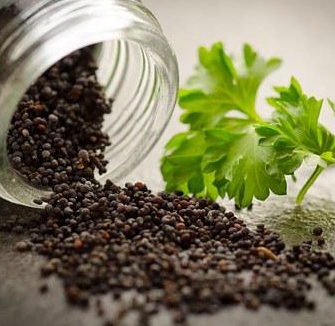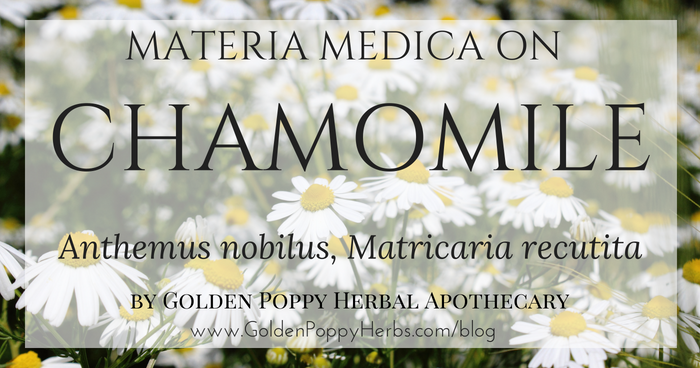KEEP THE KIDS CALM
Chamomile is the Mary Poppins of herbs, singing kids (and adults) off to sleep, easing common colds, and generally restoring balance. But unlike nanny’s who fly with umbrellas and walk on chimney smoke, Chamomile is quite common.
Chamomile is an exceptionally versatile plant. It works wonders for digestive issues and helps with relaxation and sleep, soothing your children if they’re a bit too wired.
Because of its mild warming capacity, Chamomile is great for colds and flus. It can help break a fever or settle the stomach, plus it’s gentle enough for children of all ages, as well as elders who may be more sensitive.
Chamomile tea washes and chamomile essential oil are also great for skin inflammation issues; rashes, poison oak/ivy, eczema, acne, psoriasis, and others can all benefit from topical applications of chamomile.
One of the amazing things about it is how effective it is, given its simplicity. It’s one of those herbs that is good for so many different situations, it’s excellent to have on hand. It also tastes great all by itself, so having a cup of simply chamomile tea isn’t going to make your children say “gross.”
If you’re in a situation at home, and you can’t think of anything else to use, try chamomile. At the very least, it will help you relax and feel more under control.
Never underestimate the power of thinking clearly, Mary Poppins wouldn’t.
MATERIA MEDICA: CHAMOMILE
Common Names: German Chamomile, Roman Chamomile
Latin Name(s): Matricaria recutita, Anthemis nobilis
Plant Family: Asteraceae
Parts Used: Flowers picked when blooming in summer
Botanical Description: Annual with delicate, feathery leaves growing from a smooth stem. Chamomile can grow anywhere between 6-24 inches in height. Flowers are white with a puffy yellow disk in the center.
Preparation & Dosing:
- Tea: 2 teaspoons infused into 8oz hot water for 5-10 minutes…any longer and it may get bitter
- Bath: (great for helping kids get to sleep), make a large batch of the tea on the stove and add to the bathwater. Allow children to soak in the tub. Also helps to add Epsom salts to the bathwater. You can also use the essential oil
- Tincture: 1 – 4 mL, 1:5 in 40%, three times a day.
Energetics: neutral to cool, very slightly dry, can be bitter if steeped too long
Parts Affected: GI tract, nervous system
Actions:
- carminative
- nervine relaxant
- anti-spasmodic
- anti-inflammatory
- anti-microbial
- anxiolytic
- tonic
- vulnerary
- anodyne
- analgesic
- mild bitter tonic
Biochemical Constituents: volatile oils, flavonoids, glycosides, tannins, alkaloids, polysaccharides, coumarins
Primary Uses:
- Primary use is in any kinds of stomach issue
- Is very good for calming children
- Good for IBS
- Relaxes the stomach, decreases stomach sensitivity
- Helps nausea, morning sickness, motion sickness and nervous indigestion
- Relaxant to acid indigestion
- Soothing and tonic for gastric distress 2-3 hours after a meal
- Good for gastric ulcers and gastritis
- Also good for diverticulitis
- Also calming to the nervous system, helps in any situation that has a stomachache and sleeplessness
- Good for colds
- Will decrease hemorrhoid swelling
- Good as an enema for mucous colitis and spastic colitis
- Good to heal wounds faster, internally and externally
- Helps both constipation and diarrhea
- Is a good relaxant and eases menstrual pain
- Good for restless and over complaining individuals, when a person refuses to be comforted
- Also good for allergies and asthma
- Is interchangeable with Roman Chamomile Anthemis nobilis
Cautions:
Is part of the Asteraceae family, which is related to ragweed, so some individuals may be allergic to it.
Browse by category
- Aromatherapy
- Astrology & Magic
- Ayurdeva
- Botany Foraging & Gardening
- Chakras
- Digestion
- Earth Connection
- Energetics
- Flower & Gem Essences
- Folk Traditions
- Herbalism & Holistic Health
- Immune Support
- Materia Medica
- Mushrooms
- Nutrition
- Seasonal Living: Autumn
- Seasonal Living: Moon
- Seasonal Living: Spring
- Seasonal Living: Summer
- Seasonal Living: Winter
- Skin & Body Care

Don’t Miss a Thing!
Enter your email below to be the first to know about sales, new products and tips for taking care of your pieces.



